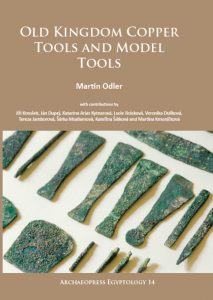In 2016, research project, focused on the published and unpublished copper alloy Egyptian finds in the museums, resulted in publication of a book Old Kingdom Copper Tools and Model Tools. The book comprises tools and model tools preserved from ancient Egyptian Old Kingdom.
Abstract:
 The Old Kingdom of Egypt (Dynasties 4–6, c. 2600–2180 BC) is famous as a period of the builders of the largest Egyptian pyramids. It is generally accepted that the evidence on the use of copper alloy tools from this era is meagre. Martin Odler gathers the textual, iconographic and palaeographic evidence and examines Old Kingdom artefacts in order to revise this view on the use of copper alloy tools and model tools. Furthermore, he provides updated definitions of tool classes and tool kits, together with the context of their use.
The Old Kingdom of Egypt (Dynasties 4–6, c. 2600–2180 BC) is famous as a period of the builders of the largest Egyptian pyramids. It is generally accepted that the evidence on the use of copper alloy tools from this era is meagre. Martin Odler gathers the textual, iconographic and palaeographic evidence and examines Old Kingdom artefacts in order to revise this view on the use of copper alloy tools and model tools. Furthermore, he provides updated definitions of tool classes and tool kits, together with the context of their use.
Besides rare specimens of full-size tools, the largest corpora of the material have been preserved in the form of model tools in the burial equipment of the Old Kingdom elite and were most probably symbols of their power to commission and fund craftwork. Moreover, the size and elaboration of the model tools were probably connected to the social status of the buried persons. The long-standing division in the Egyptological literature between full-size tools and model tools is questioned.
The ancient sources also enable to show that the preservation of material culture from the Old Kingdom was largely dependent on a conscious selection made within the past culture, with completely different settlement and funerary contexts and a conspicuous absence of weapons. The volume is completed by co-authored case studies on archaeometallurgy of selected Old Kingdom artefacts in the collection of the Egyptian Museum of Leipzig University, on morphometry of Old Kingdom adze blades and on the finds of stone and ceramic vessels associated with the findings of so-called Old Kingdom model tools.
The book can be purchased here. It is also available in many university and public libraries around the world.
